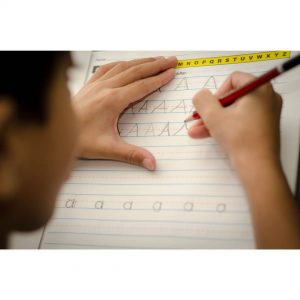
Teaching and Improving Handwriting Skills
February 4, 2022In this digital age of computers, tablets, and smartphones, handwriting seems to be becoming a lost art. We adults who remember the days before computers and the internet were mainstream (gasp!) may not think too much about this, but our children have no other frame of reference. This present reality is all they know, and while they may be able to type some of us under the table, neat handwriting may be a struggle for them. So, what do we do? As with anything, practice makes perfect! Let’s discuss some helpful ways to teach handwriting skills.
Improve Handwriting Skills With Fine Motor Skill Development
First, what are fine motor skills, and why do they matter? Fine motor skills refer to the movements and strength of the small body muscles, namely fingers, hands, and wrists. If one’s fine motor skills are underdeveloped, they won’t be able to adequately grip or manipulate objects like scissors, crayons, pencils, etc. If their grip strength is lacking, they’ll definitely have trouble when it’s time to write. The best thing to do is strengthen those little muscles!
The best way to build handwriting skills in your little learner actually occurs before a pencil ever touches paper. Just as one must learn to crawl before they can walk, those fine motor skills must be built up before one can properly grip a pencil to write. There are many ways you can help your child get those muscles where they need to be. Here are a few suggestions:
- Peeling Stickers – While our parental instinct may be to jump in and help our kids, let them work at getting their stickers off of a sheet. This simple activity involves concentration, coordination, and fine motor skills!
- Pom Pom Play – Whether it is adding them to a kitchen whisk and having your little one remove them, lining them up inside of drawn circles on a paper, dropping them into an empty water bottle, or any number of other activities, these nifty little balls are a great means to improve fine motor skills.
- Pasta Play – Pasta is another fun, inexpensive tool that can be used to strengthen those muscles. Best of all, there are so many options!
- You can use macaroni noodles and yarn to make a necklace, or get the colored noodles and go big by making a room decoration. (Note: This can also be done with Cheerios, Fruit Loops, beads, etc. The threading is what works those fine motor muscles.)
- Grab a colander, some dry spaghetti noodles, and turn your little ones loose sticking the noodles in the holes.
- Want to get in some fun scissor practice without making confetti? Get a big plastic tub, add some cooked spaghetti noodles, give your kid some child scissors, and let them have some fun by cutting the noodles.
- Q-Tip Painting – Take a break from finger painting or painting with paintbrushes, and let your child try painting with a Q-Tip. Because of its size and shape, they have to use their pincher grip to manipulate it, so it works those key muscles.
- Tweezer Transfer – Moving anything from one place to another with big, plastic, kid tweezers is fun for children and helpful for their fine motor development. Whether it is pom poms or socks or plastic insects or whatever you have that can make a fun activity, play with the tweezers!
I could go on and on mentioning different fine motor activities. They are simple, fun (popping bubble wrap is another one!), and very helpful when it comes to preparing for or improving your child’s handwriting skills.
Improve Handwriting Skills With a Correct Pencil Grasp
When your child first begins writing, it is extremely beneficial for them to learn how to properly grip a pencil. This will more than likely be up to you to repeatedly demonstrate and correctly place the pencil in their hand. If you simply allow them to pick up and hold a pencil in whatever way is most comfortable for them, odds are high that it will not be the correct way to grasp and use a pencil.
properly grip a pencil. This will more than likely be up to you to repeatedly demonstrate and correctly place the pencil in their hand. If you simply allow them to pick up and hold a pencil in whatever way is most comfortable for them, odds are high that it will not be the correct way to grasp and use a pencil.
You may be wondering, “What’s the big deal?” Well, while a correct vs incorrect pencil grip may not seem like a life-altering issue, it does have a major impact on their handwriting…which they will use and need throughout their life. Knowing how to correctly grasp a pencil will simply make their life (and certainly their years of education) a little easier.
Maybe now you’re saying, “My child has already adopted an incorrect grasp. What do I do?” If this is the case, there are things you can do to teach and encourage them to hold their pencils properly.
- Play with Playdoh. Going back to fine motor activities, a great one to improve the pencil grip is playing with playdoh or clay. Squeezing and manipulating the playdoh or clay is building strength in those first few fingers that are necessary for gripping a pencil.
- Use “Stop and Go” fingers. Teach your children that their thumb, index, and middle fingers are their GO fingers, while their ring and pinkie fingers are their STOP fingers. The most common proper pencil grasp uses those first 3 fingers – the tripod grip. Teaching that these are their GO fingers will help them remember and recognize if they revert back to their previous incorrect grip.
- Use a Pencil Grip. If all else fails, add a pencil grip to their pencil. These simple grips (like this one or this one) are great whether your child is right- or left-handed to help them learn a proper grasp, and will ultimately improve their handwriting.
For additional handwriting practice, be sure to download our free Handwriting Practice Printables below!
Additional Homeschool Handwriting Resources
How and Why We Teach Cursive Handwriting
Help! My 3rd Grader Doesn’t Like to Write!
How to Plan for Writing Success
Why Your Teen Needs to Know Cursive
Fine Motor Skills Activities for Preschoolers
How to Help Dyslexic Students With Writing
Teaching Writing to Students With Autism
Naomi White
Naomi White graduated with her B.S. in Christian Elementary Education and went on to earn her Early Childhood Education certification. She has taught preschool and elementary school in both Christian and public schools. She loves to read and write, is a pastor’s wife and stay-at-home mom, and is eagerly awaiting the day her son is old enough for them to start their own homeschool journey. Originally a Georgia girl, Naomi currently lives in the beautiful mountains of North Carolina with her family.
Latest Posts

While nearly every college and university today is eager to accept homeschooled students into their institutions, homeschooling families need to understand that their student’s application…
Read more >
Guest Post by Gabriel Morse For several years, I sat for long hours every day behind one of those battleship gray desks in a windowless, dull, gray office. The pay was enough to take care…
Read more >
This post is sponsored by Little Monsters Universe. I'm Tina Salmanowitz, an advocate for homeschooling and science education. With over a decade of experience as a science educator (in class…
Read more >

